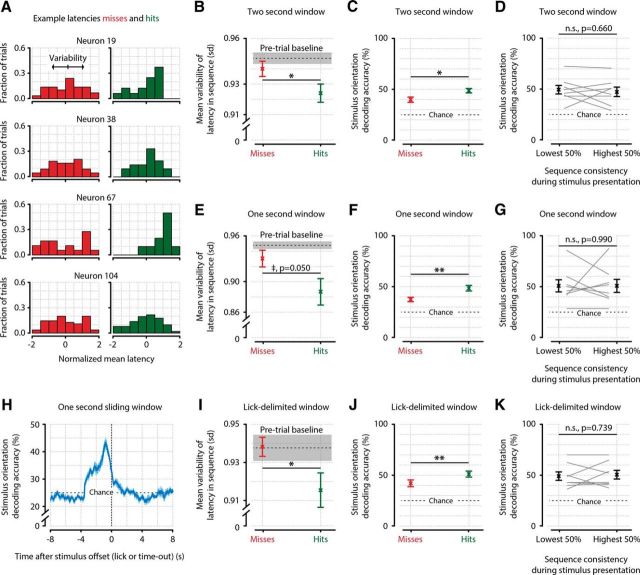Figure 9.
Temporal sequence consistency and orientation decoding accuracy correlate with the detection of stimuli, but not with each other. A, Four example neurons, showing the distribution of latencies across miss trials (red; left) and hit trials (green; right). B–G, The variability is calculated by taking the SD of latencies across PEs per neuron, and averaging across neurons. B, Quantification of the variability in latency across animals (n = 8) shows that the temporal sequence of neuronal activation is less variable during the detection of a stimulus (hit) than when it remains unreported (miss) (paired t test, n = 8, p = 0.035), confirming the results shown in Figure 8F. C, Decoding of stimulus orientation shows that neuronal population activity represents stimulus orientation more accurately when it is behaviorally reported (miss vs hit decoding accuracy, paired t test, n = 8 animals, p = 0.026). D, Sequence consistency and decoding accuracy are not correlated across trials, suggesting they represent two neural phenomena that independently correlate with stimulus detection (paired t test, p = 0.660, not significant). E–G, Same as B–D, but with a shorter analysis window of 1 s after stimulus onset. A shorter analysis window leads to the latency variability correlate of stimulus detection showing borderline significance (E, paired t test, n = 8 animals, p = 0.050) but does not influence the correlation of decoding accuracy with stimulus detection (F, p = 0.004) or the lack of interaction between the two (G, p = 0.990). H, Sliding-window (1 s) orientation decoding, centered on stimulus offset. Shortly after stimulus offset, orientation decoding performance returns to chance level (25%, horizontal dotted line). I–K, Same as B–D, but now for analysis windows that are delimited by the licking response for hit trials, and by random assignment of hit-trial durations for miss trials. The results are quantitatively and qualitatively similar to taking a 2 s window, showing that the specific parameters of the time windows chosen do not strongly affect the results (hit vs miss t tests; I: latency variability, p = 0.045; J: stimulus decoding accuracy, p = 0.008; K: correlation between orientation decoding and sequence consistency, p = 0.739). *, p < 0.05; **, p < 0.01 n.s., Not significant.

